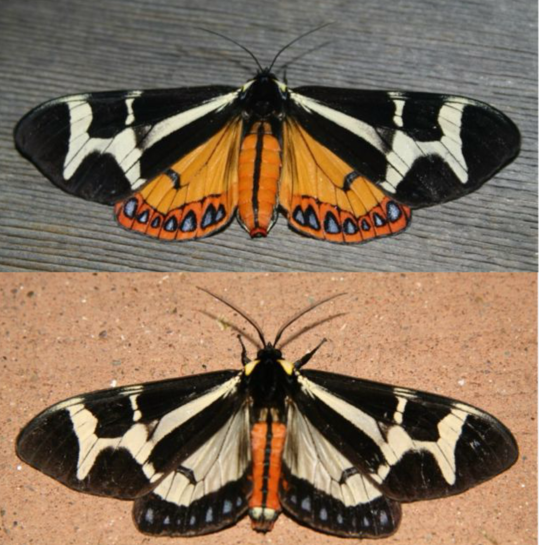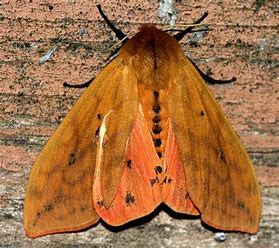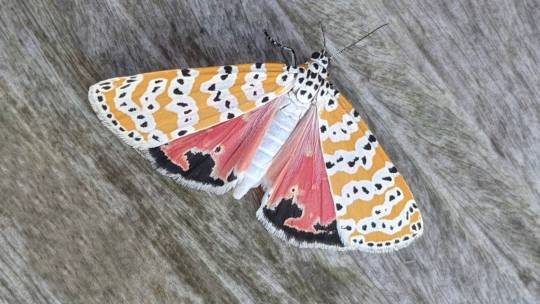#arctiidae
Explore tagged Tumblr posts
Text


as a doctor i'm prescribing you 700mg of look at some bugs
#bflyart#bug doodles#blattidae#theridiidae#arctiidae#sciomyzidae#ulidiidae#bibionidae#scoliidae#formicidae
537 notes
·
View notes
Text

Euplagia quadripunctaria | Les Papillons dans la Nature (1934) | Paul-André Robert (1901-1977)
257 notes
·
View notes
Text



[PHOTOS TAKEN: JULY 4TH, 2023 | Image IDs: Three photos of a white, grey, and brown tiger moth on a white woven tarp /End IDs.]
#moths#moth#lepidoptera#insects#insect#bug#bugs#bugblr#entomology#arthropods#invertebrates#inverts#photos#photo#Wasp House Sights#Arctiidae
46 notes
·
View notes
Photo

Marian Ellis Rowan (1848-1922, Australian) ~ One hundred and fifty-eight medium- and small-sized moths, in seven columns. A wide range of families is represented, including the NOCTUIDAE, ARCTIIDAE, LASIOCAMPIDAE, LYMANTRIIDAE, GEOMETRIDAE, PYRALIDAE, SESIIDAE, etc.
Watercolour with bodycolour on green paper
[Source: Christie’s]
34K notes
·
View notes
Text
Frother Moths (Genus Amerila): when these moths feel threatened, they secrete a frothy yellow substance from the glands on their thorax, producing chemicals that are distasteful to predators

Above: Amerila astreus
Moths of the genus Amerila are commonly known as "frother moths," because they can produce a pungent, unpalatable froth in order to deter predators. A distinctive "sizzling" or "hissing" sound is also emitted as the frothy substance bubbles out.

Above: Amerila crokeri, commonly known as Croker's frother moth (top), and Amerila rubripes, also known as Walker's frother moth (bottom)
The substance, which has a bright yellow or orange appearance, is secreted from the prothoracic glands located near the base of each wing, just behind the moth's eyes.
As this article explains:
If molested, resting adults produce quantities of a frothy, orange fluid from their prothoracic glands, accompanied by a sizzling sound. The froth not only has an aversive odor to humans but also contains PAs [pyrrolozidine alkaloids] which are likely taste-repelling. This phenomenon applies to all the Amerila and has been recorded from other Arctiids including Creatonotos.

Above: close-up of Amerila crokeri secreting its bright yellow froth
The adult moths are pharmacophagous, obtaining the aversive chemicals that are used to create their froth by ingesting plants that contain toxic/noxious compounds. Those compounds are then sequestered within the moth's body, where they are repurposed as a defensive secretion.

Above: Amerila astreus
The genus Amerila contains dozens of documented species, all of which are known to possess this defense mechanism. They are widely distributed throughout many different parts of the world; depending on the species, they can be found in the Himalayas, Indochina, Southeast Asia, Melanesia, Australia, or Central/Southern Africa.

Above: Amerila crokeri
Sources & More Info:
Metamorphosis Australia: The Australian Arctiid Moths
Metamorphosis Australia: Weird and Wonderful Moths
Australian Lepidoptera: Amerila crokeri
Entomo Brasilis: Defensive Froth in Arctiidae Species in the Rio Grande do Sul State, Brazil (PDF)
Moths of Australia: Adult Adaptations for Survival
Advances in Insect Chemical Ecology: The Curious Relationship Between Tiger Moths and Plants Containing Pyrrolozidine Alkaloids (PDF)
Neotropical Entomology: A Fieldwork-Oriented Review and Guide to PA-Pharmacophagy
#entomology#lepidoptera#arthropods#frother moth#genus amerila#moths#bugs#insects#defense mechanisms#chemical defense#animal facts#colorful moths#the frothy pom pom defense
195 notes
·
View notes
Text
Moth of the Week
Northern Giant Flag Moth
Dysschema howardi

Image Source
The northern giant flag moth is a part of the family Erebidae. It was first described in 1836 by Johann Christoph Friedrich Klug. This moth is known by two scientific names: Dysschema thetis and Dysschema howardi, which are considered to be synonymous. This moth’s scientific name may also be confused with Dysschema mariamne, which is the name of Mariamne’s giant flag moth.
Description Males and females have very similar patterned forewings that are black and white. They also both have red-orange abdomens, black heads, and black thoraxes with two yellow and white spots. However, both males and females have different hindwings, antennae, and sizes:
Females have orange hindwings while males have white ones.
A male’s antennae is fluffier than a female’s
Males are generally smaller than females
Males also tend to be more active.
Wingspan Range (Wikipedia): 85-95mm (≈3.35-3.74in)
Wingspan Range: (BreedingButterflies): 75-105mm (≈2.95-4.13in)
Diet and Habitat The larvae of this species eat on plants from the Asteraceae family such as Brickellia californica, Eupatorium rugosum, and Vernonia patens. Adults do feed, most likely nectar from flowers as when bred in captivity they are fed sugary liquids.
This species is found from south-western United States to north-western Mexico, specifically the states of Arizona, New Mexico, and Texas. They prefer habitats that are hot and dry.
Mating These moths can be seen flying from June to August and presumably mate during this time. When bred in captivity, if these moths are not fed Brickellia californica or other plants containing pyrrolizidine alkaloids they will not want to mate. This is possibly because some species in the Arctiidae subfamily use PAs to create mating pheromones and defend themselves from predators.
Predators Larvae of this species hide under objects during the day and are more active at night. Adults are known to show their hindwings to frighten off predators or play dead.
Fun Fact When the larvae of this moth is ready to pupate, it finds a place and spins a silk “hammock” to pupate in.
(Source: Wikipedia [1][2], BreedingButterflies, Texas Entomology)

Requested by: @rodereicus
#libraryofmoths#animals#bugs#facts#insects#moth#lepidoptera#mothoftheweek#Erebidae#northern giant flag moth#Dysschema howardi#Dysschema thetis
40 notes
·
View notes
Text
Des images de chenilles provenant d'applications sur la nature ont permis à des chercheurs d'étudier l'émergence d'une nouvelle espèce de chenille
See on Scoop.it - EntomoNews
Crowd-sourcing images of caterpillars from nature apps allowed researchers to study the emergence of a new species of caterpillar.
Crowd-sourced science sheds light on how new species form across space and time
Katie Marshall, University of British Columbia et Emily Black, University of British Columbia
The fall webworm is a moth found from Mexico to Canada. (Shutterstock)
-------
NDÉ
Traduction
Imaginez une jungle. Il s'agit probablement d'une forêt luxuriante, remplie de chants d'oiseaux et du bourdonnement de milliers d'insectes différents. Imaginez maintenant une toundra : un terrain stérile, balayé par le vent, avec relativement peu d'espèces de plantes ou d'animaux.
Ces deux lieux mettent en évidence un phénomène intéressant : certains endroits de la Terre comptent beaucoup plus d'espèces que d'autres. En fait, la répartition des espèces sur le globe suit un schéma curieusement cohérent : en général, il y a plus d'espèces près de l'équateur et moins à mesure que l'on se rapproche des pôles. Ce "gradient latitudinal de biodiversité" peut être observé dans de nombreux groupes d'organismes différents au fil du temps.
L'une des explications possibles de la présence d'un plus grand nombre d'espèces près de l'équateur est que les changements climatiques entre l'équateur et les pôles affectent la capacité de nouvelles espèces à évoluer - un processus appelé spéciation.
La diversité en action
Notre équipe de recherche de l'université de Colombie-Britannique a fait appel à des outils et à des espèces uniques pour déterminer exactement comment le climat influe sur l'évolution et ce que cela signifie pour l'apparition de nouvelles espèces. Et nous avons mené ces recherches alors que nous étions bloqués à la maison pendant le COVID-19.
(...)
L'étude
Crowd-sourced observations of a polyphagous moth reveal evidence of allochronic speciation varying along a latitudinal gradient | PLOS ONE, 13.07.2023 https://journals.plos.org/plosone/article?id=10.1371/journal.pone.0288415
Compléments sur l'espèce
The Great Webworm Hunt · iNaturalist https://www.inaturalist.org/projects/the-great-webworm-hunt
r/K‐like trade‐off and voltinism discreteness: The implication to allochronic speciation in the fall webworm, Hyphantria cunea complex (Arctiidae) - Yang - 2017 - Ecology and Evolution - 4.11.2017 https://onlinelibrary.wiley.com/doi/10.1002/ece3.3334
Bernadette Cassel's insight:
Crowd-sourcing images of caterpillars from nature apps allowed researchers to study the emergence of a new species of caterpillar.
0 notes
Text

Marian Ellis Rowan (1848-1922) One hundred and fifty-eight medium- and small-sized moths, in seven columns. A wide range of families is represented, including the NOCTUIDAE, ARCTIIDAE, LASIOCAMPIDAE, LYMANTRIIDAE, GEOMETRIDAE, PYRALIDAE, SESIIDAE, etc. Watercolor with bodycolor on green paper
1 note
·
View note
Text
MothFizzPOP!
Time to crack open a can of MothFizzPOP...
"Episode" 1: The Isabella Tiger Moth (Pyrrharctia isabella)


Found in the United States and southern Canada, this moth was first named by James Edward Smith in 1797. The isabella tiger moth is a cold loving moth, which can even be in the arctic!
These moths live 7-10 days as adults, ideally. These moths are in the Arctiidae class of moths.
Kingdom: Animalia Phylum: Arthropoda Class: Insecta Order: Lepidoptera Superfamily: Noctuoidea Family: Erebidae Subfamily: Arctiinae Genus: Pyrrharctia
These moths bare orange wings and are typically 22-26 mm in length. Just look at this friendly little guy!
These moths make great additions to collections, The bright orange colors are a pleasant sight and add a beautiful POP of color to any collection! These moths sell for an estimated range of 13 USD - 45 USD on ETSY!
Now for the Moth Fizz Flavor... Sunkist Fizz, Owned by Dr. Pepper. Nutrition facts of a can of Sunkist: Energy- 833 kJ (199 kcal) Carbohydrates- 48.4 g Sugars- 48.4 g Fat- 0 g Protein- 0 g Sodium- 2% · 34 mg

Thanks for tuning in to this episode of MothFizzPOP! We hope you enjoyed this soda sized sip of moth info, and we wish to share another MothFizz with you again soon! Happy Mothing! <3
0 notes
Text


the other day i found a miniscule fuzzy caterpillar. it was by the outdoor entrance to our unfinished basement. maybe in the subfamily Arctiidae?
1 note
·
View note
Text

Pest control? Now there's one Leizu hasn't heard before. It might almost be offensive, but she has to believe this man is simply an appalling judge of character. So she allows a rare, indulgent smile. "Simply an amateur lepidopterist looking to add to my collection." she explains, holding the jar at an angle so that he might enjoy the sight of the creature.
People sometimes act like Leizu is a hard woman to impress, but really you don't have to do much: calling the moth incredibly magnificent instead of acting like its icky or scary has already endeared him to her. "Of the Arctiidae family, I should think. You're very fortunate to work here, surrounded by such fascinating visitors. I hope you don't mind me depriving you of this one's company." Not that she'd release it even if he wanted her to, but... diplomacy, et cetera.

Sebni's curiosity was piqued when he saw a rather attractive woman lurking around his greenhouse. He has never seen anyone like her before, a rather attractive woman lurking around his greenhouse. He has never seen anyone lurking around his greenhouse. No one at all. Still, he refrained from making any hostile movements, remembering his greenhouse seemed to have mutated into having the ability of drawing some of the most deplorable and dangerous folks to it. Like a very harmless flame to an overgrown, fireproof moth.
“ What...is that? ” Ever the curious plant scientist, Sebni's curiosity transferred from the intruder toward the thing she had trapped. He raised an eyebrow, examining it as he moved closer to the jar, to her, already almost forgetting the trespass. “ That is incredibly magnificent. Are you from pest control? ”
5 notes
·
View notes
Photo

1K notes
·
View notes
Text

This, like all Clymene moths, has a funny little cross on its back!
#Tiger moths#Arctiidae#Moths#Moth#Insect#Insects#Bugs#Bug#arthropods#Entomology#Hymenoptera#Photo#Photos#Wasp House Sights
141 notes
·
View notes
Text
Moth of the Week
Ornate Bella Moth
Utetheisa ornatrix

This moth was first described as Phalaena ornatrix and Phalaena bella by Carl Linnaeus in 1758. In 1960, it became known as the Utetheisa ornatrix by William Trowbridge Merrifield Forbes. It’s also called the ornate bella moth, ornate moth, bella moth or rattlebox moth and is in the family Erebidae.
Description The body is white with black spots on the back of the thorax and head. The legs are black and white and antennae are black and filiform. The hindwings are a pale or bright pink with an irregular black border. The forewings are orangish-yellow with white bands surrounding black dots. Patterns may vary. These colors are used to warn predators of the moth’s toxicity.
Wingspan range: 33 - 46 mm (1.3 - 1.8 in)
Diet and Habitat The larva feed on plants of the Crotalaria species such as Avon Park rattlebox, rabbitbells, smooth rattlebox, and showy rattlebox. These plants provide the larva and adults with alkaloid compounds which are the unpalatable to predators. They accumulate these toxins from the seed pods of these plants, however if the larva can’t eat a seed pod due to competition they will have to eat the leaves where is concentration is much lower. Larvae may prey on/eat others of its kind to maintain high levels of alkaloids. Alkaloids are also passed down from parents to eggs.
Its northern most range is from Connecticut westward to southeastern Nebraska and southward to southern New Mexico and Florida in the United States. Its southern most range is from Mexico, South America, and Central America. It’s southernmost reach is southeastern Brazil. This species is more common in tropical parts of this range due to host plant populations.
Mating This species demonstrates a form of sexual selection. The females choose a male to mate with based on the intensity of their pheromones. During mating, the females receive a “spermatophore” from the males containing sperm, nutrients, and alkaloid compounds. After mating, the females choose which males’ sperm fertilizes the eggs. Usually, the female chooses the male with the most alkaloids which tends to be the larger males. Adult males invest up to 11% of their body mass to create a spermatophore they provide to a female during mating. The nutrients given in the spermatophore allow the female to produce an average of 32 additional eggs in her brood.
Females mate an average of 4-5 times and up to 13 times, each with a different male. In the north there there two generations per year with more in the south.
Predators The larva and adults keep predators at bay with alkaloid compounds accumulated during feeding and inherited from parents. These toxins make them unpalatable to their main predators: spiders and bats. Specifically, the adult moth secretes an alkaloid foam from its head when threatened. However, larva and moths with low concentrations are more susceptible to predation than those with higher concentrations who are usually released and unharmed after being caught.
These toxins do not work against some predators like loggerhead shrikes.
Unlike other moths of the Arctiidae subfamily, this species moth does not have a way to audibly communicate their toxic which would help it to avoid bats altogether.
Fun Fact This species was first described on 1758 by Carl Linnaeus as two different species: Phalaena ornatrix was used to describe the paler moth specimens, and Phalanea bella, described the bright pink moth specimens. It was then moved to the genus Utetheisa in 1819 by Hübner. After nearly a century of struggling to identify this species and its subspecies, Forbes combined both species Utetheisa ornatrix and Utetheisa bella into one in 1960: Utetheisa ornatrix.
(Source: Wikipedia; The Island Packet; Institution of Food and Agricultural Sciences, University of Florida)
#libraryofmoths#animals#bugs#facts#insects#moth#mothoftheweek#lepidoptera#ornate bella moth#bella moth#rattlebox moth#ornate moth#Erebidae#Utetheisa ornatrix
131 notes
·
View notes
Text
No Rain by Blind Melon
The House That Dripped Blood by The Mountain Goats
Call Me by Blondie
Figure In The Background by Snake Pool
Have To Explode by The Mountain Goats
@arctiidaes
(tagged by @pipcoded)
list 5 songs you've been listening to recently
the way i understood this prompt is to list songs you've been listening to repeatedly lately, not just the last 5 songs you've listened to (because if i did that i'd just list the PMD EoS OST lol)
in no particular order:
Rainbow Road (Final Lap) (In-Game Version) - Mario Kart DS
Skies Forever Blue/Toby Fox & Itoki Hana
Replay (2019): A Metal Tribute to the History of Video Games
Love Like You (feat. Rebecca Sugar) (End Credits)
Waters of Megalovania (ORIGINAL)
tagging: @thicc-pirate, @l-i-n-u-s-k-a, @featheredcritter, @kaddppa, @rowan-e-ravenwood, @pitiable-arisen and anyone else who feels like it!
35 notes
·
View notes